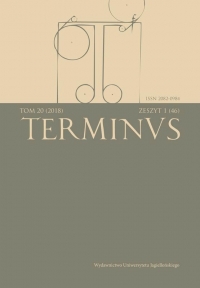The Poetical Map of Europe: Jan Kochanowski’s Ode II 24 and Its Cartographical Dimensions
The Poetical Map of Europe: Jan Kochanowski’s Ode II 24 and Its Cartographical Dimensions
Author(s): Jakub Niedźwiedź Subject(s): Studies of Literature
Published by: Wydawnictwo Uniwersytetu Jagiellońskiego
Keywords: Renaissance cartography; Polish Renaissance poetry; Jan Kochanowski; imitation;early modern national identity; Europocentrism; cartographic reason
Summary/Abstract: The paper deals with the problem of the cartographic imagination in Polish Renaissance literature. The other problem discussed is the impact of cartographic reason on establishing the early-modern national and European identity of the Poles. The methodological approach of the paper is inspired mainly by critical cartography (J.B. Harley). Map is defined here in its relatively wide meaning. It is not limited only to material representations, but it is also understood as a performance, a gesture and a form of thinking (D. Woodward, J. Pickles). The main text examined here is the ode II 24 by the Polish Renaissance poet Jan Kochanowski (1530–1584). The poem concludes his lyrical cycle published posthumously in 1585 and it is a Polish imitation of the Ode II 20 by Horace (Non usitata nec tenui ferar). In the first part of the paper the author exhibits the context of the sixteenth-century use of maps. The cartographic revolution of that time made a great impact on art, literature, philosophy etc. Renaissance humanists all over Europe lived within the maps and used them as a tool or as a means of expressing, defining and shaping their ideas. In this part of the paper it is shown when and where Kochanowski would have consulted or watched and read the maps. The second part of the texts compares the poem by Kochanowski and its Horatian model. The author recalls the results of previous interpretations by J. Ziomek, L. Szczerbicka-Ślęk and others. Kochanowski’s version is almost a translation, but the Polish poet rewrote Horace’s ode in a specific way. He swapped the ancient names of places and put in their place the names of the regions of sixteenth-century Europe. In the consequent analysis, the author argues that it is not only a sample of Renaissance metonomasy, but it shows the more complex process of replacing one cartographical imagination with another. While the cartographic imagination of Kochanowski was based on the Ptolemaic tradition and its early modern transformations, the ode by Horace evokes the tradition of maps similar to the Porticus Vipsania in Augustan Rome and copies the Tabula Peutingerina. Therefore, the metacartographies of the poets should be seen as different. The final part of the paper shows yet another difference between the two poems. While the gaze of the Roman poet trespasses the limina of the Roman Empire, Kochanowski is looking only at the European and not very distant Mediterranean regions. The author concludes with the hypothesis that this European orientation became typical for Polish poetry of the 16th and 17th centuries. This Europocentric focus is one of the distinct features of Polish literature that made it different from literatures of the countries interested in overseas colonial endeavours.
Journal: TERMINUS
- Issue Year: 20/2018
- Issue No: Special
- Page Range: 79-103
- Page Count: 25
- Language: English

